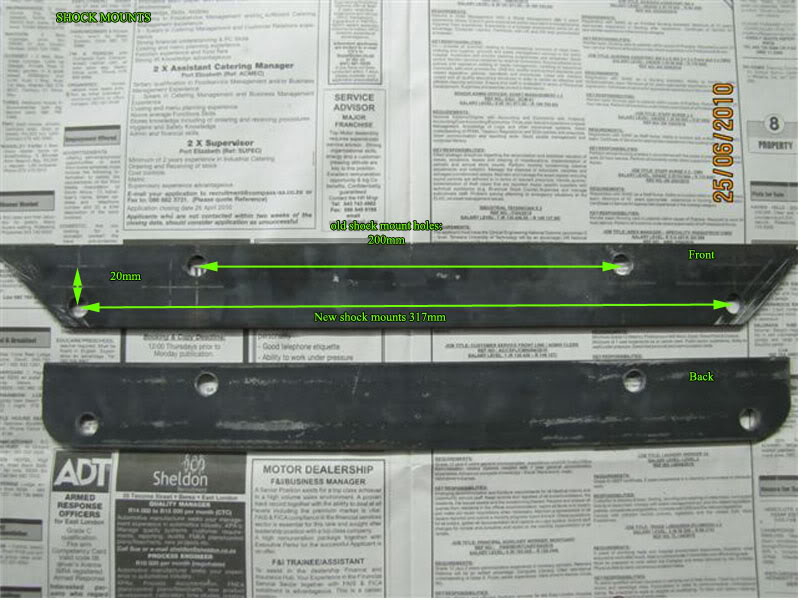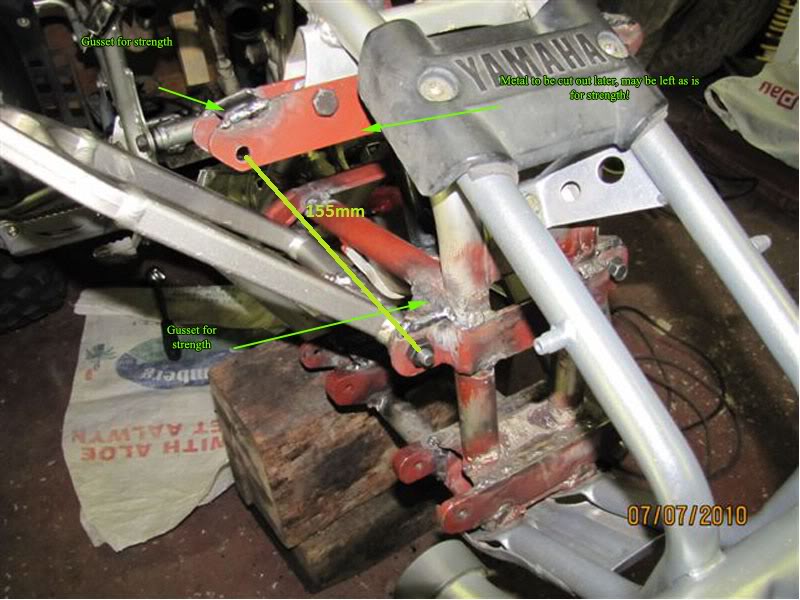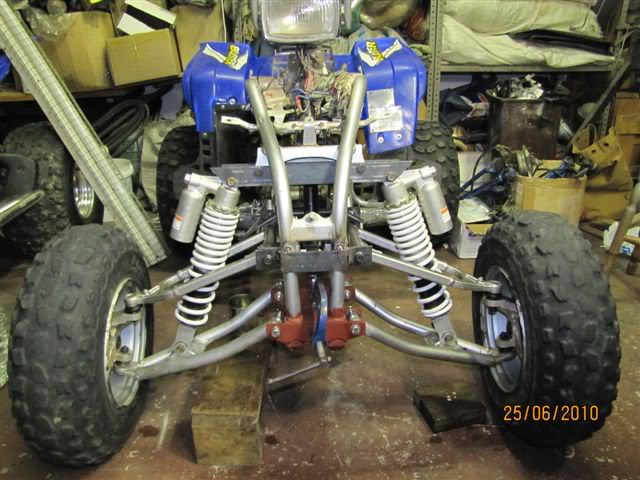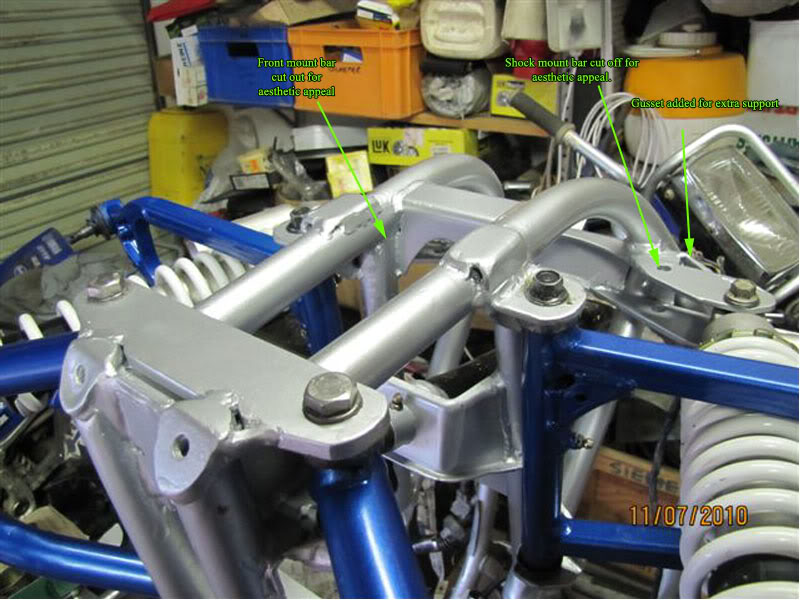Kilowatt Monster
- Thread starter JohnSwitch
- Start date
You are using an out of date browser. It may not display this or other websites correctly.
You should upgrade or use an alternative browser.
You should upgrade or use an alternative browser.
What brand skid is that? Looks nice, great clamps.
Thanks glad you like it! The skid plat and clamps are "home made".
A friend design the plate and I did the brackets on CAD. Then I just had the profiles laser cut and bent out of aluminium.
Very nice skids and mounting! If you still haven't gotten that idle screw to work, try this, loosen the cable from the thumb throttle adjuster about three four turns, then move that brass adjuster down a few threads, next fire it up let it warm up, then using that idle adjuster adjust idle to desired idle speed, then adjust the slack in your cable. -Slick
I think it is time that I make some more mods to my blaster. I am going to install a 400ex rear shock. This clip by Ken OConner explains the process well. Just trying to find a good deal on EBay because shipping the shock to South Africa is going to cost me more then the actual shock 
400 ex shock on Blaster.wmv - YouTube
I am also going to put new front shocks on the quad. I just dont know what shocks. The Banshee shocks I have on now are way to soft with the 3" extend a-arms. I ripped my belly plate of the other day when the bike air about 2 feet in the air. I am trying to find some shocks that will not brake the bank but from what I have seen the chances are slim. Any ideas?
400 ex shock on Blaster.wmv - YouTube
I am also going to put new front shocks on the quad. I just dont know what shocks. The Banshee shocks I have on now are way to soft with the 3" extend a-arms. I ripped my belly plate of the other day when the bike air about 2 feet in the air. I am trying to find some shocks that will not brake the bank but from what I have seen the chances are slim. Any ideas?
Blaner
Your Friendly South African Ambassador
why not go the YFZ shock route? sorry I never got back to you about shock lengths but it sounded like you got the figure.
why not go the YFZ shock route? sorry I never got back to you about shock lengths but it sounded like you got the figure.
Hi Blaner
I did get hold of the lengths thanks! I am not so keen on the YFZ route because I will have might have to cut my mud guards. I was planing on making a bracket like in the attached photo because the length of the YFZ shock is longer then a blaster shock but it requires me to remove or cut my plastics I think. If I cant fine other shocks that fit for a good price then I will have do the YFZ shocks.
Attachments
Blaner
Your Friendly South African Ambassador
i dont see why it would hit your fender. You should not need to move it out that much.
This is how much I had to move by when fitting them with the 450 A arms.
The inner holes are for the stock blaster shock mount holes on the frame and the outter ones are for the 450 shock.




This is how much I had to move by when fitting them with the 450 A arms.
The inner holes are for the stock blaster shock mount holes on the frame and the outter ones are for the 450 shock.




Thanks Blaner I see what you are saying. I just think I will have to mount the shock higher because I don't have YFZ a-arms. If I do what you did then the bikes nose will be much higher and it might not be good for the ball joints? What I think I am going to do is try get holed of some YFZ450 shocks and then work from there.
I was looking and checking again now and I think you right I can make it work. Just got to find some shocks! I:I
Blaner
Your Friendly South African Ambassador
well, when making the bracket to mount the shocks, you can basically design your our ride height. do this by either putting a jack under the frame at the front or by using a block and tackle and winch it up from a roof beam or something. Take the wheels off, Now jack up the frame and measure from a set point on the frame to the ground (best take off the bumper and use the front end of the frame) jack up the bike until you find the height you are looking for. I suggest you measure another bike to get an idea of what the height should be. I used a yfz 450 to get my ride height.
Once you have it jacked at the right height, put the shocks in on the bottom mount only. then position the shock to the point were you feel they should be. Be careful here tho, you need the shock at the right angle or else they will loose their efficiency at absorbing bumps.
What I did was measure the distance apart of the stock blaster top shock mounts (200mm in 1st pic) then I measured the same thing on the YFZ, it was 300mm. Then because of my frame being wider than a YFZ and my overal width was going to be 17mm wider than the YFZ, I had to add 8.5mm on each side of the YFZ's measurement of 300mm making it 317mm. This then kept the proportions and geometry of the 450 and transferred it to the blaster thus putting the shock at the same angle.
So now I knew how wide apart my top mount should be (X axis) but I still needed the height (Y axis) this is where the jacking the frame story comes in. I matched my ground clearance with the 450 and that resulted in the mounting points being a little lower than the stock blaster ones, as in the pic, so along the 317mm line I held the shock and set the ground clearance. Then make left and right the same.
Its hard to explain. Takes a bit of logic when doing.
In your case, Id suggest getting a ground clearance value off another bike, or set it where you feel it looks right then add +3 to the 200mm of the blaster shock mount width (are your arms +3 inches on each side??)
Another method, because like you say you are not using 450 arms, is to measure the angle of the shock on a 450 in relation to the horizontal plane and apply the same angle to your bike. You can use a carpenters sliding bevel to do this.
I suggest reas through my report on what I did in the suspension section (sticky) and that should help you getn an idea of the logic you need to apply. I didnt go into too much detail with this there but i may have mentioned something else I have since forgotton!
Once you have it jacked at the right height, put the shocks in on the bottom mount only. then position the shock to the point were you feel they should be. Be careful here tho, you need the shock at the right angle or else they will loose their efficiency at absorbing bumps.
What I did was measure the distance apart of the stock blaster top shock mounts (200mm in 1st pic) then I measured the same thing on the YFZ, it was 300mm. Then because of my frame being wider than a YFZ and my overal width was going to be 17mm wider than the YFZ, I had to add 8.5mm on each side of the YFZ's measurement of 300mm making it 317mm. This then kept the proportions and geometry of the 450 and transferred it to the blaster thus putting the shock at the same angle.
So now I knew how wide apart my top mount should be (X axis) but I still needed the height (Y axis) this is where the jacking the frame story comes in. I matched my ground clearance with the 450 and that resulted in the mounting points being a little lower than the stock blaster ones, as in the pic, so along the 317mm line I held the shock and set the ground clearance. Then make left and right the same.
Its hard to explain. Takes a bit of logic when doing.
In your case, Id suggest getting a ground clearance value off another bike, or set it where you feel it looks right then add +3 to the 200mm of the blaster shock mount width (are your arms +3 inches on each side??)
Another method, because like you say you are not using 450 arms, is to measure the angle of the shock on a 450 in relation to the horizontal plane and apply the same angle to your bike. You can use a carpenters sliding bevel to do this.
I suggest reas through my report on what I did in the suspension section (sticky) and that should help you getn an idea of the logic you need to apply. I didnt go into too much detail with this there but i may have mentioned something else I have since forgotton!
Thanks Blaner I understand what you are saying.
The Banshee shocks are 375mm eye to eye and the YFZ shocks are 400mm. What I think I might do is just pop them right in with no mod just to see how much they lift the bike. Then I will see about making brackets. I attached a photo of my current setup.
The Banshee shocks are 375mm eye to eye and the YFZ shocks are 400mm. What I think I might do is just pop them right in with no mod just to see how much they lift the bike. Then I will see about making brackets. I attached a photo of my current setup.
Attachments
Hey found some YFZ450 shocks! Cost me R1000, +- $123
Will be popping them on the blaster next weekend. The weekend after that I hope to have my TRX400 shock and will put that on as well.
Cant wait to see the improvement I:I
Just going to test them out, then pop of the coils and get them epoxy coated and they will look as good as new.
Will be popping them on the blaster next weekend. The weekend after that I hope to have my TRX400 shock and will put that on as well.
Cant wait to see the improvement I:I
Just going to test them out, then pop of the coils and get them epoxy coated and they will look as good as new.
Attachments
Blaner
Your Friendly South African Ambassador
Blaner
Your Friendly South African Ambassador
I can’t really say how they feel because I have only tested in my driveway. I have transport problems at the moment but I hope to give them a proper test next weekend. My initial impression is that the are going to be sick!
Can’t wait!
Can’t wait!
Blaner
Your Friendly South African Ambassador
Blaner
Your Friendly South African Ambassador
looks good that shock is in real good condition, mine had perished seals and after two weeks i ended up with a puddle of oil on the ground and a pogo-stick suspension.
Rebuilt it with a kit and its one of the best things you can do to a blaster.
Bushes look good too!
Rebuilt it with a kit and its one of the best things you can do to a blaster.
Bushes look good too!
Similar threads
- Replies
- 12
- Views
- 3K






